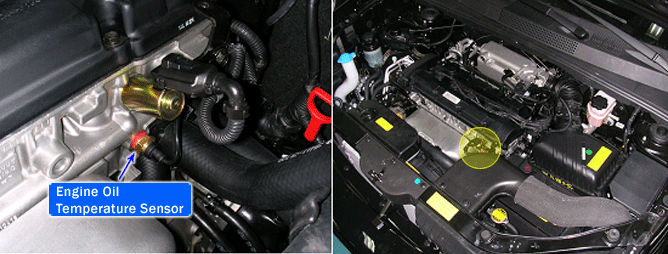Has a problem been found?

▶ Repair as necessary and go to "Verification of Vehicle Repair" procedure

▶ Go to "Component Inspection" procedure

The fluid of the CVVT is the engine oil and its density changes according to the engine oil temperature. At this time the Oil Temperature Sensor (OTS) helps compensation against the temperature differences. The Oil Temperature Sensor measures the engine oil temperature before the engine oil comes into the Oil-flow Control Valve (OCV). According to the measured temperature, the Engine Control Module (PCM) compensates the oil-flow control valve operation time.
The purpose of this diagnosis is to detect a stuck oil temperature signal or unplausibly low ,high signal. For the stuck signal detection, the PCM checks whether after a variation of the calculated oil temperature also a variation of the measured oil temperature is detected and sets DTC P0196 if the variation of the measured oil temperature is lower than the threshold. For the unplausibly high, low signal detection, the PCM compares measured engine oil temperature with calculated oil temperature or coolant temperature and sets DTC P0196 when one of following conditions is met.
Measured oil temperture is unplausibly low when calculated oil temperature is high.
Measured oil temperature is unplausibly high when coolant is low without any relevant failure.
ITEM | DETECING CONDITION | POSSIBLE CAUSE | |
Case1) | DTC Strategy | ● Signal stuck | ● Contact resistance in connectors ● Faulty OTS |
Enable Conditions | ● Engine coolant temperature at start < 40°C(104°F) ● No relevant failure ● 6 < Battery voltage < 16 | ||
Threshold Value | ● Calculated oil temperature increase> threshold but measured oil temperature increase < threshold(Threshold depends on Coolant temperature at start) | ||
Diagnostic Time | ●10~30 minutes depending on coolant temperature at start and drive pattern | ||
Case2) | DTC Strategy | ● Signal plausibility | |
Enable Conditions | ● No relevant failure ● 6 < Battery voltage < 16 | ||
Threshold Value | ● Coolant temperature at start < 40°C(104°F) & calculated oil temperature > 70°C(158°F) & measured oil temperature < 20°C(68°F) ● Coolant temperature < 70℃(158°F) & measured oil temperature > 100℃(212°F) | ||
Diagnostic Time | ● 15 seconds | ||
Temp.(°C) | Temp.(°F) | Resistance(kΩ) | Temp.(°C) | Temp.(°F) | Resistance(kΩ) |
-20 | -4 | 16.52 | 40 | 104 | 1.11 |
0 | 32 | 6.00 | 60 | 140 | 0.54 |
20 | 68 | 2.45 | 80 | 176 | 0.29 |

Many malfunctions in the electrical system are caused by poor harness(es) and terminals. Faults can also be caused by interference from other electrical systems, and mechanical or chemical damage.
Thoroughly check connectors for looseness, poor connection, bending, corrosion, contamination, deterioration, or damage.
Has a problem been found?

▶ Repair as necessary and go to "Verification of Vehicle Repair" procedure

▶ Go to "Component Inspection" procedure
Ignition "OFF"
Disconnect OTS connector.
Measure resistance between terminals 1 and 2 of OTS connector.(Component side)
Temp.(°C) | Temp.(°F) | Resistance(kΩ) | Temp.(°C) | Temp.(°F) | Resistance(kΩ) |
-20 | -4 | 16.52 | 40 | 104 | 1.11 |
0 | 32 | 6.00 | 60 | 140 | 0.54 |
20 | 68 | 2.45 | 80 | 176 | 0.29 |

Is sensor switching properly?

▶ Check for poor connection between PCM and component: backed out terminal, improper mating, broken locks or poor terminal to wire connection. Repair as necessary and go to "Verification of Vehicle Repair" procedure.

▶ Check OTS for contamination, deterioration, or damage. Substitute with a known-good OTS and check for proper operation. If the problem is corrected, replace OTS and then go to "Verification of Vehicle Repair" procedure.
After a repair, it is essential to verify that the fault has been corrected.
Connect scan tool and select "Diagnostic Trouble Codes(DTCs)" mode.
Press F4(DTAL) and confirm that "DTC Readiness Flag" indicates "Complete". If not, drive the vehicle within conditions noted in the freeze frame data or enable conditions.
Read "DTC Status" parameter.
Is parameter displayed "History(Not Present) fault"?

▶ System performing to specification at this time. Clear the DTC.

▶ Go to the applicable troubleshooting procedure.